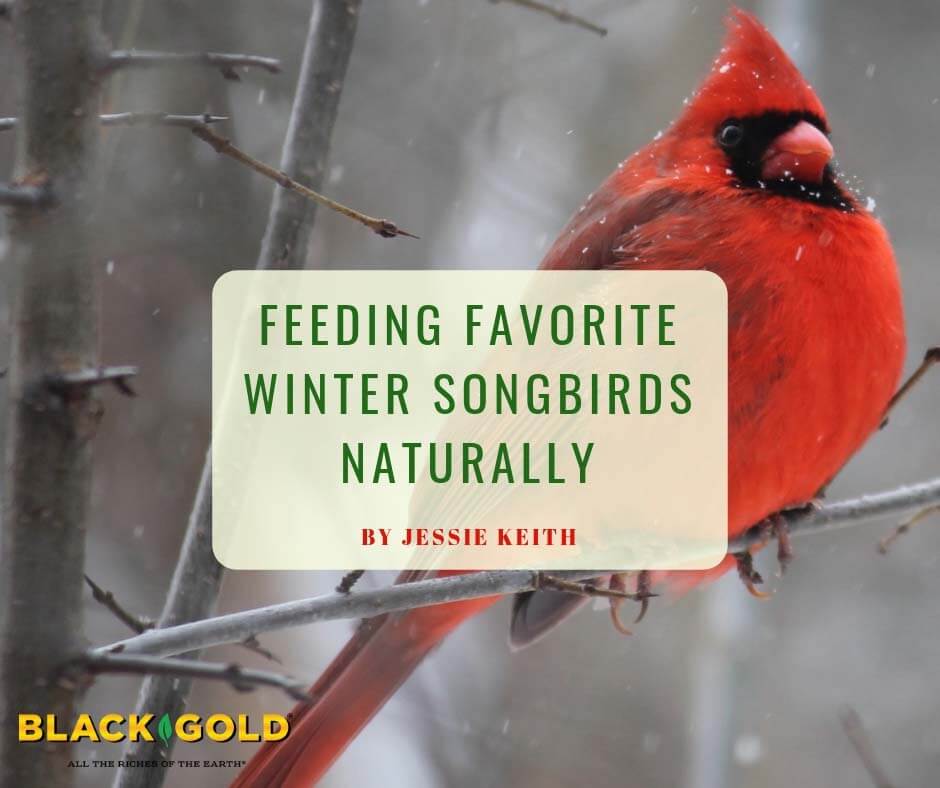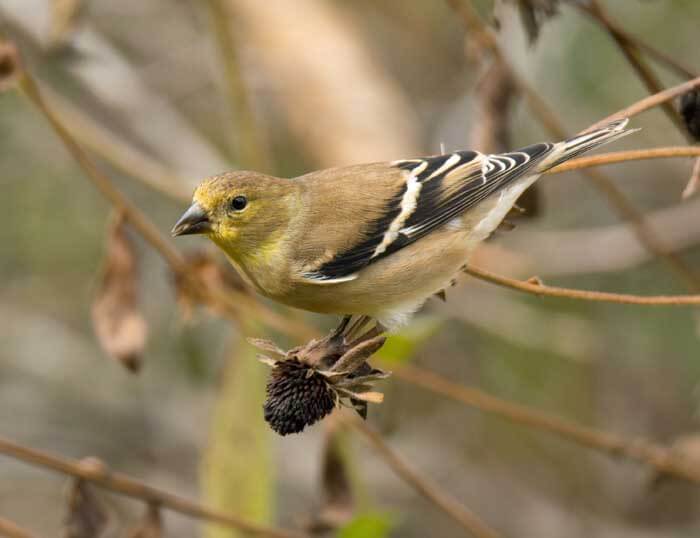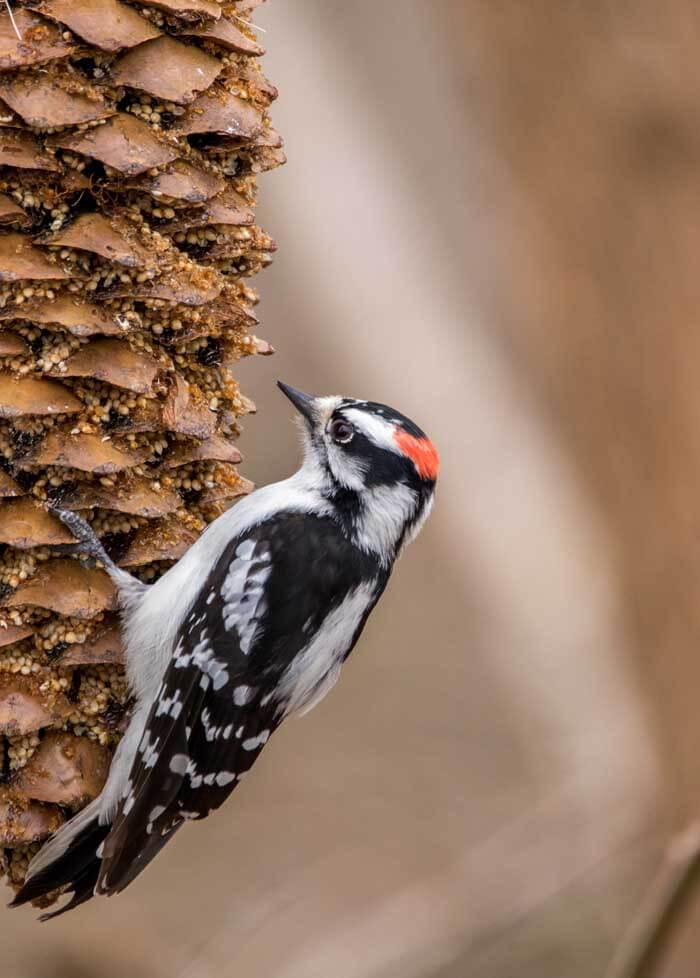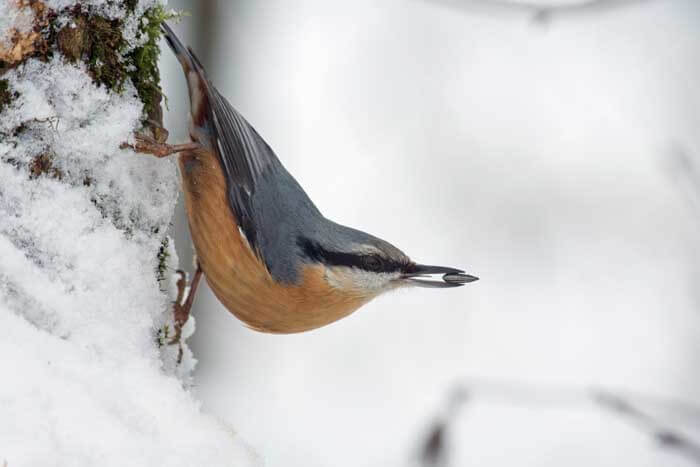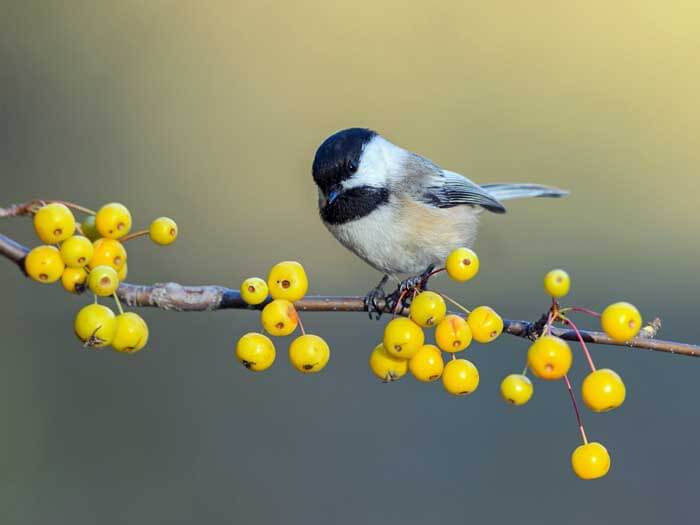A flurry of wings. A shower of seeds. Bird feeders are lively places in the winter months, and their presence is important. Natural food sources are rarer because fields and forests have been replaced by buildings and lawns, so feeders help fill a food void. But, if you have a sizable yard, you may also consider planting for birds. Many cold-season plants for winter songbirds are easy to grow and let birds feed more naturally.
Favorite Winter Birds
There are lots of common birds in North America that stick around during winter. Many of these are colorful favorites that evoke a winter feeling. Each has a unique lifestyle and story to tell. Here are ten favorites you will likely see outdoors this season, followed by some of their favorite grasses, flowers, shrubs, and trees for winter food.
-
The Northern Cardinal
Probably the most well-known and beloved of all American winter birds, the northern cardinal inhabits much of North America, from Quebec, Canada all the way down to Central America. The male birds have bright red plumage, black faces, orange beaks, and cheery red crests on their heads. The brownish-red females are less colorful, which makes them less conspicuous while nesting. Cardinals favor shrubby, forested areas and eat seeds and fruits in winter, with a supplement of insects in the summer months. Their call is a clear or trilled whistle.
Favorite Winter Foods from Plants: Dogwood fruits (Cornus florida), pearl millet (Pennisetum glaucum), sumac fruits (Rhus glabra), tulip-tree fruits (Liriodendron tulipifera), purple coneflower seeds (Echinacea purpurea), dry corn, sunflower seeds (Helianthus spp.).
-
Blue Jay
This relatively large crow relative has distinctive blue, white, and black markings and a blue head crest. Blue jays naturally exist on forest edges and wooded city areas across eastern North America. They are adaptable, somewhat aggressive birds with varied, sharp, “Craw!” calls. (Sometimes they even mimic hawk calls to frighten other birds!) The ground-foraging birds have a varied diet, eating everything from small mice to grains, seeds, and insects, but in the winter, they rely mostly on a diet of seeds.
Favorite Winter Foods from Plants: Sunflower seeds, grains, grass seeds, beechnuts (Fagus spp.), and acorns from most oak (Quercus spp.) trees.
-
Cedar Waxwing
The beautiful cedar waxwing is a master flyer capable of aeronautic turns in the sky. Its plumage is tawny brown on the top and pale yellow on the belly. The crested birds have red markings on their wingtips and yellow markings on their tail tips. These woodland natives like treed neighborhoods and can be found from northernmost South America up to Canada. Cedar waxwings don’t visit feeders but primarily eat fruit and enjoy overripe berries on winter shrubs. Their call is a high-pitched, trilling whistle.
Favorite Winter Foods from Plants: Cedar fruits (Juniperus spp.), Hawthorns fruits (Crataegus spp.), Crabapples (Malus spp.), Holly berries (Ilex spp.), Rosehips (Rosa spp.), and Viburnum fruits (Viburnum spp.).
-
American Goldfinch
Gold plumage with black markings makes these birds nearly impossible to misidentify. Finches of all types are small, seed-eating birds that always frequent feeders. The American goldfinch exists across much of North America and northern Mexico, where it favors open fields, parks, and lowlands–anywhere where thistles, asters, and sunflowers are common. Their chirpy, melodic song patterns are variable but distinctive. Females have lighter yellow bellies but otherwise look like males.
Favorite Winter Foods from Plants: Composite seed heads such as sunflower seeds (Helianthus spp.), coneflower seeds (Echinacea spp.), black-eyed-Susan Seeds (Rudbeckia spp.), aster seeds (Symphyotrichum spp.), Joe-Pye-weed seeds (Eutrochium spp.)
-
Tufted Titmouse
A small, silvery gray bird, the tufted titmouse has a smart little tufted head crest, a whitish belly, and equal or rusty patches flanking the wings. It can be found only in the eastern United States and adjacent Canada where it exists in lower elevation forests and wooded neighborhoods. Its varied diet consists of insects, nuts, seeds, and small fruits. This species nests in tree holes and feeds in tree canopies and on field plants for winter food. Sometimes they use their fast, repetitive whistling calls to rally in groups and attack threatening predators, like hawks!
Favorite Winter Foods from Plants: Berries as well as seeds and nuts, including acorns, beechnuts, and evergreen cones.
-
Downy Woodpecker
One of the most common and adaptable of the woodpeckers, downy woodpeckers are relatively small birds easily distinguished by their black and white checkered wings, white backs, and black-striped heads patched with red. They reside across the whole of North America, from Alaska to Florida, where they live in open woodlands, scrubby areas, and wooded neighborhoods. The insect-eaters rely on suet at winter feeders but will also eat seeds and berries. They make a loud, percussive “rat-a-tat-tat” when pecking trees and have a shrill, whinnying call.
Favorite Winter Foods from Plants: Sunflower seeds, berries, acorns, and grains.
-
Nuthatch
Long beaks, attractive gray, black, and white markings, and white bellies are the key identifiers of the white-bellied nuthatch. Native to much of North America, these forest-dwelling birds survive on a diet of insects, nuts, and seeds. Their long, strong, silvery beaks can easily wedge open nuts. The loud call of the nuthatch hammers on with a rapid “wha-wha-wha”.
Favorite Winter Foods from Plants: Sunflower seeds and nuts, such as acorns (Quercus spp.), beechnuts, hazelnuts, hickory nuts (Carya spp.), and walnuts (Juglans spp.).
-
Mourning Dove
Ground-foraging mourning doves are smooth tawny gray with flecks of black on their wings. The common North American birds mate for life and are often seen in pairs. They are very prevalent in open wooded areas, fields, and yards where they can be seen scouring the ground and low-lying plants for seeds and nuts. 99% of their diet is made up of seeds. They emit mournful coos and nest in trees.
Favorite Winter Foods from Plants: Seeds from wild and cultivated grasses, amaranth (Amaranthus spp.), sweetgum seeds (Liquidambar styriciflua), weed seeds, and sometimes berries.
-
Carolina Wren
In fall, you can hear the “tea party, tea party, tea party” songs of defensive Carolina wrens staking out their winter territories. Existing across the eastern United States down into adjacent Mexico, these small birds have cinnamon-brown plumage and perky tails that stick upwards. They like dense vines and bushes where they can forage on insects and small vertebrates. In the winter, they switch to a diet of fruits and seeds.
Favorite Winter Foods from Plants: Seeds from bayberry (Morella pensylvanica), sweetgum (Liquidambar styriciflua), and poison ivy (This is not a reason to keep poison ivy in the yard!).
-
Black-Capped Chickadee
A common bird across northern North America, the black-capped chickadee is a small bird with a distinctive black cap and chin, gray and white wings, buffy tan body, and little beak. It inhabits shrubby forests and wooded neighborhoods where it forages for insects, seeds, and nuts. Spiders are also a favorite treat! The males do most of the singing with a high-pitched, two to three-note “fee-bee” whistle.
Favorite Winter Foods from Plants: Sumac (Rhus spp.), honeysuckle fruits (Lonicera spp.), hemlock seeds (Tsuga spp.), bayberry fruits, and sunflower seeds.
A Winter Bird Garden
Lots of fruits and nuts found on garden flowers, trees, and shrubs will feed birds through winter. Planting for birds has become more and more popular. Winterberries, juniper berries, bayberries, hawthorn berries, sunflowers, purple coneflowers, and asters are just a few easy landscape and garden plants birds love. One way to understand how to create a designer garden for wildlife is through the National Audubon Society’s backyard conservation resources. They offer native plant lists for birds and other wildlife to teach gardeners how to turn their yards into bird havens.
Winter Bird Food Table
Most ardent bird feeding folk like to supply a diversity of food types to attract different bird species. Many birds require the addition of suet in their winter diets, as well as nuts and fruits. This table makes it easy to plan a feeding garden for these birds.
Table 1: Favorite winter bird foods
| Bird | Millet | Cracked Corn | Sunflower Seed | Wild Fruits | Thistle Seed | Suet |
| American Goldfinch | X | X | X | X | ||
| Blue Jay | X | X | X | |||
| Cardinal | X | X | X | |||
| Carolina Wren | X | X | ||||
| Cedar Waxwing | X | |||||
| Chickadee | X | X | X | |||
| Downy Woodpecker | X | |||||
| Mourning Dove | X | X | X | X | ||
| Nuthatch | X | X | X | X | ||
| Tufted Titmouse | X | X | X |
Providing Winter Bird Cover
Birds have all kinds of tricks up their wings when it comes to handling the cold. Dense down feathers line their bodies to store heat, they eat a lot to put on fat reserves and burn energy, and they seek all kinds of protective shelter from the harsh winter weather.
Tall plant cover, in fields and byways, creates dense shelter for many birds, but large uncut perennial gardens and shrub borders can give them comparable protection. Other winter birds nest in tree holes, while others may even seek refuge under the warm eaves of buildings. Dedicated winter birders may even put up protective roosting boxes to give their birds shelter in winter.
To learn more about birds in your yard visit Cornell University’s All About Birds page, and join their Project Feeder Watch to provide data about the birds in your yard.

